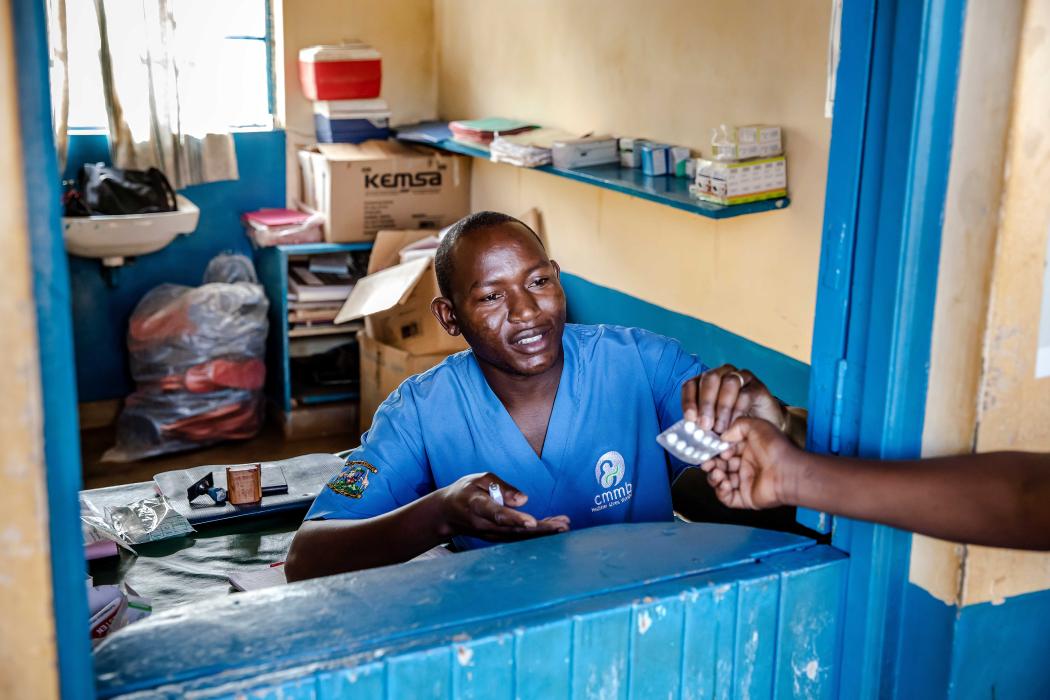Targeting Noncommunicable Diseases in Kenya with Medical Donations

A health worker distributes medication to a patient at the CMMB-funded Kalambani Dispensary in Kitui South, Kenya. Photo by Luis Tato/Getty Images for CMMB.
An assessment of CMMB’s Medical Donation Program pointed CMMB toward a new focus in NCDs that supports health workers' needs.
Right now, there is a health worker somewhere around the world scouring every shelf of her remote hospital pharmacy for the medication that could save a patient’s life—if the supply has not run out. Ongoing shortages of medication in low- and middle-income countries, especially those needed to treat noncommunicable diseases (NCDs), are likely not your first consideration when defining a crisis. But they are no less an emergency.
Just a few days ago, the global health community recognized World Hypertension Day to raise awareness about one of the deadliest NCDs around the globe. Despite the fact that four out of every five people with hypertension live without access to adequate treatment, investments in NCDs continue to fall short of the need.
CMMB’s Medical Donation Program distributes medicines and medical supplies to support health workers providing care in the world’s most fragile health systems. In 2023, CMMB shipped $414.3 million worth of medicines and medical supplies globally, including over $12 million worth of anti-hypertensive drugs. But that is a drop in the bucket given the 1.28 billion adults living with hypertension globally. In 2022, we invited an external partner to assess CMMB’s Medical Donations Program. Our goal was to determine the program’s current impact and help us identify opportunities to shape an even stronger path forward.
The assessment drew from surveys and interviews with a sample group of more than 100 partners who distributed CMMB donations in the past three years, the facilities who receive the donations, and the health workers who save lives with them. The interviews aimed to assess not only what medications and supplies were most needed but the underlying issues impacting a health worker’s access to them.
"Drugs to treat NCDs are among the products most requested by health workers."
This assessment combined with global trends, internal data from CMMB’s decades of supply requests, and further qualitative research, left us with key findings including:
- CMMB’s Medical Donations Program offers high-quality medicine and medical supplies to health facilities where budget limitations result in bare pharmacy shelves. Medical donations remain a critical need.
- Rates of chronic disease, including hypertension and diabetes, are growing at an alarming rate and disproportionately impact low-and middle-income countries. According to the WHO, in 2019, 82% of all people with hypertension lived in low- and middle-income countries.
- Drugs to treat NCDs are among the products most requested by health workers due to the growing rates of disease and ongoing drug stockouts. While many conditions require consistent, even lifelong adherence, these stockouts, compounded by inefficient supply chains, have a deadly consequence.
- CMMB can help decrease shortages by coordinating efforts between our pharmaceutical partners and health facilities to more efficiently procure and distribute noncommunicable disease medications into the hands of health workers—starting with two of the top five contributors to death globally: hypertension and diabetes.
Targeted Global Impact Initiative for NCDs
Drawing from our research, CMMB’s medical donations team laid the groundwork for a new project within the program. The goal is to decrease the burden of NCDs by partnering with pharmaceutical companies to make sure health facilities have a reliable supply of the medications needed to effectively treat hypertension and diabetes. We are now piloting the program in Kenya, and working in close coordination with the Ministry of Health as we map out the nation’s supply chain and identify pain points in product distribution.
Twenty-seven partner facilities have been identified to participate in the project pilot. No one understands the local supply chain better than the facilities who depend on it to save lives. That’s why pharmacists and other health workers from these facilities are directly informing our procurement plan. They are sharing baseline data on the specific types of drug treatments for treating NCDs, quantities, and dosing—in addition to common barriers to care. All this is helping us shape an effective and efficient procurement and distribution tracking process.
"Pharmacists and other health workers are directly informing our procurement plan."
This spring, we hosted a workshop with 33 regional and local pharmacists from our partner facilities in Kenya. Their insights were essential to understand the unique challenges contributing to the burden of NCDs within their communities.
Alongside gaps in supply, participants noted community hesitation to medical care, long distances to reach health facilities, and limited awareness of NCDs as the main challenges to successful treatment. The workshop continued with discussions about how CMMB could holistically approach these challenges. For example, some pharmacists pointed to the role of community health promoters and the integration of NCDs into their ongoing training.
As we continue to organize our findings and engage pharmaceutical partners in procuring the medications, we are eager to begin tracking impact. With key indicators established and a new mobile application to streamline monthly reporting by health workers at our partner facilities, we are positioned to collect data at every phase.
As proud as I am that CMMB is testing this pilot program in Kenya, no single organization can move the needle as much as is needed. We need to see more investments in NCDs on a global scale. I think back to that one health worker scouring the empty supply shelves of her hospital pharmacy, and I look forward to the day that her shelves are fully stocked and regularly replenished.
